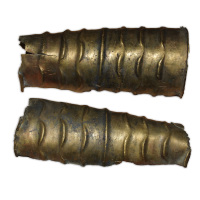Scope and Content
[Source - Chloe Rushovich for FHYA, 2020, using material provided by eThembeni Cultural Heritage Management, Gavin Whitelaw and Carolyn Hamilton: The uMgungundlovu site served as the capital of the Zulu Kingdom between 1829 and 1839. In 1828, when Dingane kaSenzangakhona succeeded Shaka to the Zulu kingship, he followed his predecessor's custom of building a number of large military amakhanda in the heart of the kingdom. Located within the eMakhosini was the largest of these amakhanda, uMgungundlovu. Fully established by 1829, it served as the royal residence of Dingane and his isigodlo, his principal advisors and a large garrison of his favoured regiments. uMgungundlovu is the best preserved of all the capital amakhanda established during the height of the Zulu Kingdom. The FHYA appointed eThembeni Cultural Heritage Management to identify all archaeological material relating to the uMgungundlovu archaeological site, including descriptions of collections; associated and peripheral materials such as museum documentation, accession information, registers, individual items; and historical notes. The uMgungundlovu archaeological site has the National Site Number Mgungundlovu 2831AD 4. eThembeni Cultural Heritage Management used record cards held at the museum, which they checked against the contents of each box and supplied the FHYA with a full inventory. The FHYA then made a selection of items for digitisation from this inventory and commissioned eThembeni to: digitise the full paper-based archive including all museum record cards; photograph all small finds and all notable items not classified as small finds; as well as to provide photographs of single sorting tray of the contents of each box classified as 'adiagnostic material'; and one photograph of a single sorting tray from one box out of the series of boxes containing each type of undiagnostic material. They were also commissioned to photograph all the museum boxes and labels pertinent to the above selection. eThembeni identified material from multiple excavations located at two institutions, the KwaZulu-Natal Museum and Amafa, as well as items collected from the site and held at the Msunduzi Museum and personal research materials in the hands of individual excavators. One of the aims of the FHYA is to enable the digital reunification of items, in this case, the dispersed archaeological record of uMgungundlovu. The FHYA eMandulo uMgungundlovu curation combines the archaeological material with associated institutional material, as well as the attached documentary material, and publications associated with the excavations the took place at the uMgungundlovu archaeological site. The FHYA has arranged the archaeological and associated institutional material into 'subseries' which are named after the primary excavators and the year in which the material was accessioned. Within these 'subseries' are 'files' containing digital 'items' which consist of collection boxes and their contents. The associated documentary and other miscellaneous material is organised in a series, and there is a further series in which the publications associated with the archaeological excavations are housed.]
Metadata
Materials excavated from the uMgungundlovu archaeological site and associated items
Creative Commons License: CC BY-NC-ND https://creativecommons.org/licenses/by-nc-nd/4.0/
| Event Actor | Event Type | Event Date | Event Description |
|---|---|---|---|
| Five Hundred Year Archive (FHYA) | Online curation | 2020 - |

Contributions